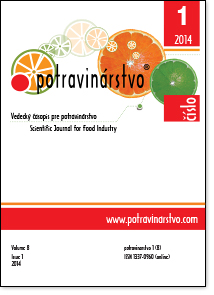Vegetable oil based emulsions in milk
DOI:
https://doi.org/10.5219/360Keywords:
grape seed oil, photon correlation spectroscopy, milk, encapsulation, emulsionsAbstract
Milk and dairy products represent an important part of functional food in the market. Based on their positive health and nutritional benefits, they have gained popularity and their consumption as well as production is on the rise in the last few decades. As a result of this trend, milk-based products are being used for the delivery of bioactive food ingredients. This study is devoted to the formulation of stable emulsions containing grape seed oil dispersed with several emulsifiers (Tween 80, monocaprylin, and lecithin) in milk. Photon correlation spectroscopy was used to evaluate the characteristics of the emulsions in terms of mean droplet size, droplet size distribution and polydispersity index. Emulsions were prepared using 2% and 5% w/w grape seed oil, and 3%, 5%, or 8% w/w emulsifier, and these were homogenized at two different rates of 1050 and 13400 rpm. Parameters influencing emulsion particle size and particle size distribution were identified, which included emulsifier type, its HLB value, oil type (virgin, refined), homogenization rate and the fat content in the milk. Homogenization at 13400 rpm for 10 min. produced fine emulsions with small mean particle sizes and monomodal distribution of droplets. Regarding emulsifier type, the smallest droplet sizes were obtained with formulations containing Tween 80 (250-315 nm), whereas lecithin primarily accounted for the monomodal particle size distributions.
Downloads
Metrics
References
Akoh, C. A., Min, D. B. 2008. Food lipids : chemistry, nutrition, and biotechnology. 3rd ed. Boca Raton: CRC Press, 928 p. ISBN 978-1420046649. DOI: https://doi.org/10.1201/9781420046649
Bail, S., Stuebigerb, G., Krista, S., Unterwegerc, H., Buchbauera, G. 2008. Characterisation of various grape seed oils by volatile compounds, triacylglycerol composition, total phenols and antioxidant capacity. Food Chemistry, vol. 108, no. 3, p. 1122-1132. https://doi.org/10.1016/j.foodchem.2007.11.063 DOI: https://doi.org/10.1016/j.foodchem.2007.11.063
Bartovská, L., Šišková, M. 2005. Fyzikální chemie povrchů a koloidních soustav. (Physical chemistry of surfaces and colloids, in Czech) 5th edition Praha: VŠCHT Praha, 245 p. ISBN 80-7080-579-X.
Burg, P., Zemánek, P. 2012. Možnosti využití matolin z vinařské produkce. (The potential of winemaking grape pomace by-products, in Czech) Vinařský obzor, vol. 105, no. 5, p. 258-259.
Chee, C. P., Gallaher, J. J., Djordjevic, D., Faraji, H., McClements, D. J., Decker, E. A., Hollender, R., Peterson, D. G., Roberts, R. F., Coupland, J. N. 2005. Chemical and sensory analysis of strawberry flavoured yogurt supplemented with an algae oil emulsion. J. Dairy Res., vol. 72, no. 3, p. 311-316. https://doi.org/10.1017/S0022029905001068 PMid:16174362 DOI: https://doi.org/10.1017/S0022029905001068
Chee, C. P, Djordjevic, D., Faraji, H., Decker, E. A., Hollender, R., McClements, D. J., Peterson, D. G., Roberts, R. F., Coupland, J. N. 2007. Sensory properties of vanilla and strawberry flavored Ice cream supplemented with omega-3fatty acids. Milchwissenschaft, vol. 62, no. 1, p. 66-69.
Janiš, R., Krejčí, J. Klásek, A. 2000. Preparation of 1-monoacylglycerols from glycidol and fatty acids catalyzed by the chromium(III)-fatty acid system. European Journal of Lipid Science and Technology, vol. 102, no. 5, p. 351-354. https://doi.org/10.1002/(SICI)1438-9312(200005)102:5<351::AID-EJLT351>3.0.CO;2-J DOI: https://doi.org/10.1002/(SICI)1438-9312(200005)102:5<351::AID-EJLT351>3.0.CO;2-J
Madawala, S. R. P. 2012. Lipid components and oxidative status of selected specialty oils. Grasas y Aceites, vol. 63, no. 2, p. 143-151. https://doi.org/10.3989/gya.083811 DOI: https://doi.org/10.3989/gya.083811
McClements, D. J., Decker, E. A., Weiss, J. 2007. Emulsion-based delivery systems for lipophilic bioactive components. Journal of Food Science, vol. 72, no. 8, p. R109-R124 https://doi.org/10.1111/j.1750-3841.2007.00507.x PMid:17995616 DOI: https://doi.org/10.1111/j.1750-3841.2007.00507.x
Shahidi, F., Bailey, A. E. 2005. Bailey's industrial oil and fat products: Volume 1, Edible Oil and Fat Products: Chemistry, Properties, and Health Effects. 6th ed. Hoboken, N.J.: Wiley-Interscience. 629 p. ISBN 0-471-38552-2.
Sharma, R. Market trends and opportunities for functional dairy beverages. 2005. Australian Journal of Dairy Technology, vol. 60, no. 2, p. 195-198. [cit. 2014-04-12] Retrieved from the web: http://www.docstoc.com/docs/ 15448681/Market-trends-and-opportunities-for-functional-dairy-beverages
Downloads
Published
How to Cite
Issue
Section
License
This license permits non-commercial re-use, distribution, and reproduction in any medium, provided the original work is properly cited, and is not altered, transformed, or built upon in any way.






























